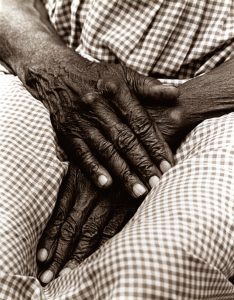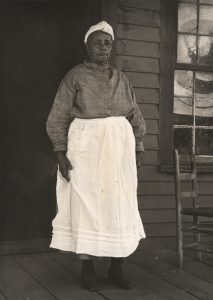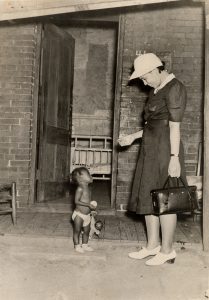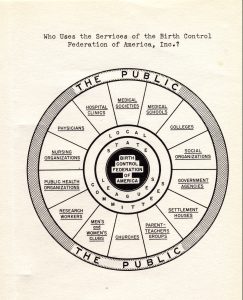Plans for a national health program failed to materialize, and campaigns to extend care to underserved populations remained episodic operations. National Negro Health Week was just that: one week of activities per year. The Alpha Kappa Alpha teams operated field clinics for a few weeks over seven summers, but they discontinued with U.S. entry into World War II. The Division of Negro Service demonstration clinics distributed birth control to a relatively small number of women over two years, but the experiment did not give rise to permanent services. Projects such as these exposed the extent of need, provided some treatment, and tested the efficacy of new contraceptive methods and the feasibility of various delivery systems, but they were short-lived. At the end of the day, community women looked to each other, especially to the midwives among them, for reliable information and continuity of care.

Through most of the twentieth century, black lay midwives were the mainstays of reproductive health care in African American communities, especially among the poor. In the rural South in the 1930s, they attended 80 percent of black births and 20 percent of white births. With black physicians few and far between, at least three thousand midwives, most of them black, practiced in Alabama. More than four thousand served in North Carolina. In the Mississippi county where AKA women ran field clinics, two African American physicians practiced among 130 midwives. Even when white doctors were willing to take care of blacks, which most were not, black women usually preferred to be in the hands of midwives.

Black midwives were in and of the community. They often recruited their own daughters or granddaughters as assistants and successors, and the novices learned by observing their elders. Physicians and poor mothers, white and black, all relied on midwives, and employers accommodated midwives’ comings and goings as they bowed out of fields, kitchens, and classrooms, sometimes for two or three days at a time, to see women through labor, delivery, and recovery. Births were social events, with family and friends gathering around to offer support. Neighbors commonly referred to midwives with admiration and affection as “the ones who got us here.” Knowing they would often go unpaid, many midwives undertook the work as a religious calling, and they routinely summoned divine assistance during deliveries. As conduits of spiritual strength, sources of medical knowledge, and sustainers of community, midwives took on status as respected leaders, alongside ministers and teachers. As one midwife’s daughter observed, midwives were considered “sainted women.” 25
Midwives were vital contacts for outside health providers attempting to introduce birth control and other information to black communities. Home demonstration agents from the U.S. Extension Service relied on midwives, and Dorothy Ferebee found their involvement essential to sharecroppers’ participation in the AKA field clinics. Public health nurses also depended on midwives. When poor African American women either could not or would not go to the demonstration clinics, the Division of Negro Service hired a few black public health nurses who extended the reach of the program through thousands of home visits.

Black public health nurses were few in number and often covered a wide territory — six served the entire state of Mississippi. During community visits, the nurses assembled midwives clubs and mothers groups for instruction on everything from sex education to the benefits of installing window screens. Local midwives and mothers then spread the new knowledge, took care of each other, did the groundwork for National Negro Health Week events, and organized around local health issues.
These local women’s networks negotiated the maze of sexual and reproductive pressures surrounding them. They shielded each others’ daughters from the advances of white men and boys who presumed entitlement to the bodies of black women. They spirited away brothers and sons who found themselves in danger of mob violence for allegedly having shown interest in white females. They sustained webs of extended kin who had migrated elsewhere and who might take in a pregnant friend and help her find a safe, though illegal, abortion. With midwives at the center, these networks mediated the interactions between poor women and expanding state-run public health and welfare systems. (Valk and Brown; Rogers 2006, chap. I).
Given the prevalence and central role of midwives, African American advisors encouraged white leaders of the birth control movement to engage midwives in the campaign. As highly educated professionals, the advisors themselves were not without bias toward the poor. It was DuBois in his 1932 essay who referred to “the mass of ignorant Negroes [who] breed carelessly” as representing “that part of the population least intelligent and fit.” The prominent club leader Mary Church Terrell bemoaned “irresponsible breeding” among blacks. Nonetheless, these advisors advocated a public health approach that tapped the broad base of community resources, including midwives, rather than a private fee-for-service model of medical care built around individual doctor-patient relationships.26

Yet midwives themselves were conspicuously absent from the circle of community groups the Division of Negro Service looked to as allies and supporters. Midwives themselves maintained an uneasy relationship with white birth control proponents and were wary of health plans that presented economic competition. For their part, white leaders tended to bypass midwives in favor of black professionals such as social workers, teachers, and nurses. The marginalization reflected mounting disregard for lay midwives. The name “granny” midwife may have been a term of endearment within the black community, but it was becoming an expression of derision from others. Although midwives boasted impressive records of safe deliveries, medical professionals and middle-class health reformers tended to disparage them as dirty and ignorant, part of the problem rather than part of the solution. Some went so far as to blame midwives for high maternal and infant mortality rates in the black community.
As states expanded public health systems, they clamped down on midwives. Boards of health began issuing licenses that required midwives to participate in educational programs, observe certain standards of dress, ensure that clients be screened by a physician, refrain from conducting internal exams or dispensing medicines, and comply with strict reporting procedures. In 1941, the Tuskegee School of Nurse-Midwifery opened for the purpose of training professional nurses who would replace lay midwives.
Lay midwives practiced for decades thereafter, but they did so under increasing scrutiny. Because only physicians could dispense birth control legally and because abortion was a crime in every state, midwives who shared traditional contraceptive substances or assisted women with abortions put their licenses and livelihoods in jeopardy. Most professed to toe the line themselves but claimed to know others who did not.
According to an annual report from the Division of Negro Service clinics in Nashville, patients reported an average of four prior pregnancies and one abortion. On the frequency of abortion, clinic staff noted, “Many patients cannot remember how many they have had.” 27 Staff estimated that the actual total was four times the number given. Assuming the conjecture had some validity, it could be that abortion was so common that women did not keep count. Maybe the distinction between abortion and miscarriage was so poorly defined that women did not fully understand the question. Or perhaps the mothers feigned poor memory in order to protect themselves and the midwives who cared for them from legal consequences.
Over time, states ceased issuing licenses to lay midwives, forcing them to practice outside the law, if at all. By midcentury the number of lay midwives began a steady, steep decline. In Mississippi, where more than four thousand black and a few hundred white midwives practiced in the 1920s, only six hundred were licensed forty years later (Smith 1995, 124, 147-48). In the absence of either public health systems African Americans felt they could trust or private medical services they could afford, the marginalization of midwives left the majority of black women to fend for themselves in the search for safe, reliable, legal birth control and reproductive care.
◊ ◊ ◊